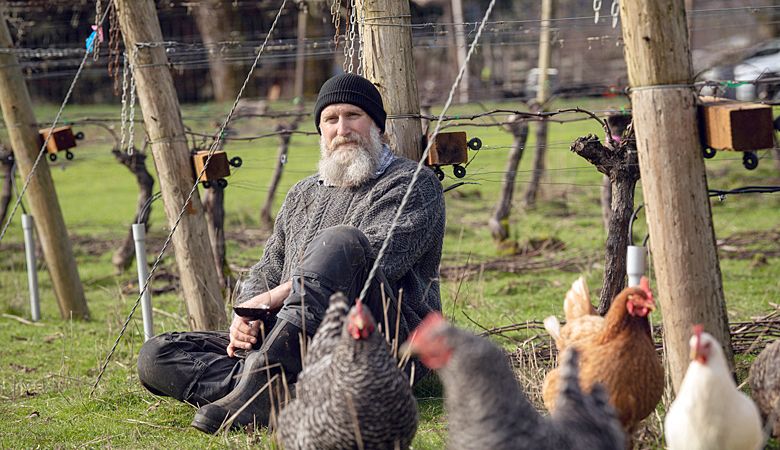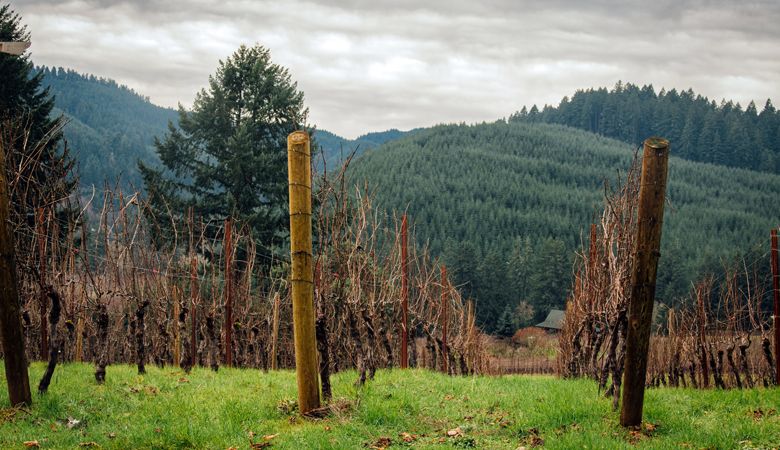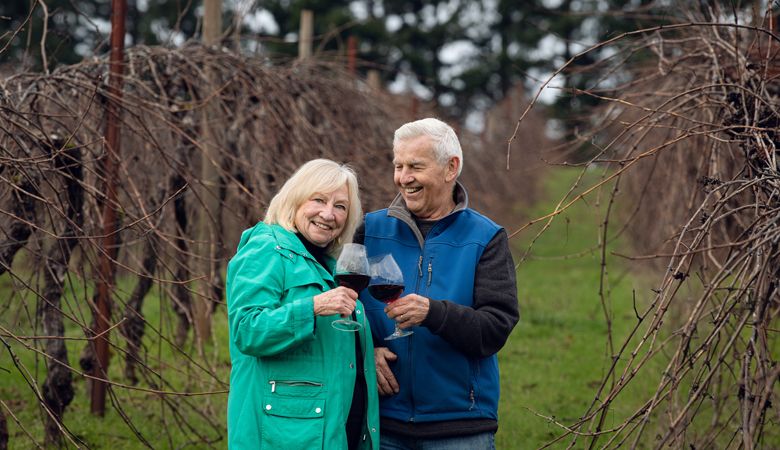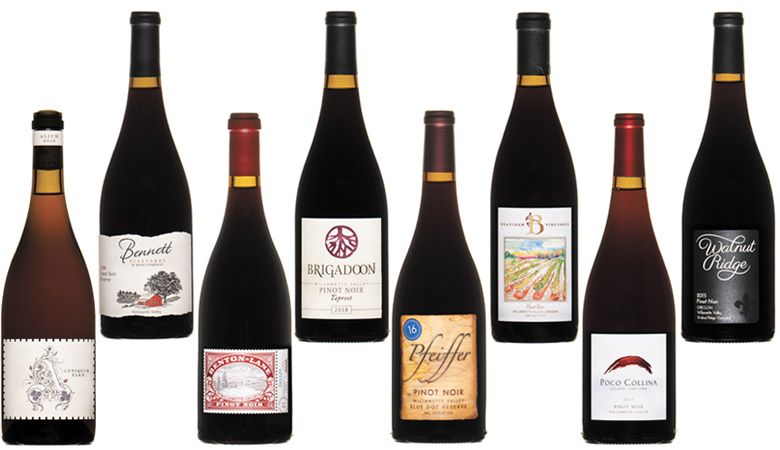At Long Last
Lower Long Tom declared Oregon's 22 AVA
When Dieter Boehm first visited the Willamette Valley in the 1970s, he noticed striking similarities with some of Germany’s top winegrowing regions. He, of course, wasn’t the only person postulating that Oregon could grow world-class Pinot Noir at the time. The difference was his location, in the rolling hills just outside Eugene.
Boehm started planting grapes at what would become High Pass Winery in 1984, the same time other vineyards, including Pfeiffer Winery (planted in 1982) and Hinman Vineyard (planted in 1979 and now known as Silvan Ridge), were planting grapevines in Lane County. He became acquainted with the other growers, many of whom lived on family farms while producing outstanding wine. Yet, he watched with dismay as time and again the southern Willamette Valley was ignored by the media.
“We were sort of the stepchild of Willamette Valley viticulture, and I didn’t think that was right,” he explains. “After I grew grapes here for 20 years, I knew we were different. Our fruit was showing excellent quality all around.”
Several years ago, spurred by Boehm, a loose-knit group known as the Prairie Mountain Wineries began talking about establishing an AVA (American Viticultural Area) west of Junction City and south of Monroe. “We really had been producing some excellent Pinot Noir and Pinot Gris, yet the southern Willamette Valley had been continuously overlooked as a premium grape-growing area,” says Danuta Pfeiffer, co-owner of Pfeiffer Winery with husband Robin. She notes a major U.S. wine magazine once published a map showing the Willamette Valley ended near Salem. “Because we weren’t near a large metropolitan area like Portland, it was hard for us to get attention.”
The group believed an AVA — a widely-recognized designation that would define for the world what made the region special — might help. Boehm wrote the application with support from other growers in the region. They called the area the Lower Long Tom after the Long Tom River, a tributary of the Willamette River — the region is loosely shaped around the river’s route below Fern Ridge Reservoir.
The AVA application, submitted to the U.S. Alcohol and Tobacco Tax and Trade Bureau in 2017, was approved Nov. 10 and went into effect Dec. 10. “It was really a great Christmas present for all of us down here,” says Pfeiffer.
As a winegrowing region, the Lower Long Tom contains two important distinctions. The AVA sits in a rain shadow thanks to 3,000-foot Prairie Mountain and some of the Coast Range’s taller peaks, blocking some of the cold weather from the Pacific Ocean.
The soil in this area is also different from many sites in the Willamette Valley. “It’s predominantly Bellpine, a sedimentary soil that is not very deep — maybe three feet —and has a limited water-holding capacity,” says Boehm. “The vineyards grown on that soil have to search and go deep into the substrate to make it through the season. I think that gives our wines a certain tannin structure that makes them really ageable and have a really good potential for showing after five, six or seven years.”
Pinot Noir is the main variety grown in the AVA, but there are numerous white varieties planted, including Chardonnay, Pinot Gris, Riesling and Sauvignon Blanc. There are 12 wineries and 24 vineyards inside the relatively large region, which covers 25,000 acres.
Stephen Hagen, owner of Antiquum Farm, believes the AVA’s size allows for unique expressions even within the defined area. “The Lower Long Tom contains some of the warmest, more advanced-ripening sites in the Willamette Valley, but also some incredibly cool, late-ripening sites. The common denominator of the Bellpine soils creates grapevines with more open canopies that produce grapes with smaller clusters and smaller berries. The wines tend to have concentrated fruit flavors, but given the differences in climate and farming methods, there’s still a lot of variety in wine styles.”
Those interested in visiting the region, which spans both Lane and Benton County, will find it low in pretension and high on hospitality. “I like to say we’re still in boots and not suits,” says Pfeiffer, who describes many of the wineries as having “rustic elegance.” “Chances are when you come to the winery, you’re going to meet the owners and the winemakers. Many are first-generation owners. We’re very close together, so you don’t have to drive very long distances to get to the other wineries, and we don’t have traffic.” The bucolic scenery makes for a beautiful drive.
People can set a wine region apart, too, and Hagen believes that’s the case in the Lower Long Tom. “There’s an abundance of growers, owners and winemakers who were born and raised on the multi-generational farms where they are now making or growing wines. I think that’s really powerful and informs people’s sensibility about how they treat their land and how they feel—the voice of their place shapes their work.”
Family is what brought Hagen back to the Lower Long Tom region. He was born and raised in the area but left to pursue a career in Southern California for many years. When it was time for him to start a family, he came back. “This place is in my bones. There’s something about this area, its people and the land that have always given me a sense of purpose and self-identity.”
The family feeling at these wineries extends from the growers to their patrons. Robin Pfeiffer was a teacher in Eugene for 30 years before transforming his family’s sheep farm into a vineyard. He has a number of ex-students who bring their kids to the winery to taste. “It’s such a kick to see them again, and to sit down and have a glass of wine,” he says.
Boehm may not have roots going back generations in the area, but he’s grateful to have ended up in this adopted home with this extended AVA family. “For me to get the opportunity in this country to find a piece of land and start growing grapes and eventually making wine, it’s a dream come true,” he says.
With the Lower Long Tom now gaining attention from professionals around the world, his dream of getting this region the recognition it deserves is well on its way to coming true.
Lower Long Tom Pinot Noir Tasting Notes
Antiquum Farm 2019 Passiflora
A stunning Pinot Noir rich with flavors and aromas of dried mango, plum, blueberry, raspberry and fresh rose petals. $68
Bennett Vineyards 2018 Reserve Pinot Noir
This double-gold medalist (2021 Savor NW Wine Competition) shows notes of dried raspberry, cranberry, roses, milk chocolate and black truffle. $45
Benton-Lane 2018 Estate Pinot Noir
Aromas of dried cherries and gravel are joined by lavender, mint and white pepper in the mouth. $30
Brigadoon Wine Co. 2018 Taproot Pinot Noir
Like a walk in the Pacific Northwest, the wine reveals flavors of brambly berries, wild herbs, towering pine and cedar trees, and salty ocean air. $40
Pfeiffer Winery 2016 Blue Dot Reserve Pinot Noir
A raspberry and rosy nose segues into a palate of cranberry, blueberry, cedar boughs, black tea and a hint of vanilla. $95
Bradshaw Vineyards 2018 Pinot Noir
There’s no doubt this Pinot Noir comes from Oregon. Classic flavors include cherries, cola, blueberry jam, lavender, baking spice and graphite.
Poco Collina 2017 Gelardi Vineyard Pinot Noir
Cherry and smoked meat on the nose lead to dried strawberries, cherries and earthy minerality on the palate. $24
Walnut Ridge Vineyard 2015 Pinot Noir
Aromas of cherry, wet stone and jasmine lead to a palate bursting with cherry, more flowers, an earthy mid-palate, minerality and firm tannins. $52
Click here for a story about Lower Long Tom's RainSong Vineyard in Michael Alberty's The Changeup.
Mount Pisgah, Polk County, Oregon
The Lower Long Tom may not retain the title of newest Oregon AVA for long. The petition for the Mount Pisgah, Polk County, Oregon AVA near Dallas is currently outstanding, and residents are hopeful it will be approved soon.
At 5,500 acres, the AVA will be one of Oregon’s smallest. (The smallest is currently Ribbon Ridge at 5,100 acres.) The area just south of the Van Duzer Corridor doesn’t get the whipping winds that distinguish that region. That means it stays warmer at night, which leads to thicker skins and wines darker and more tannic, says Brad Ford, owner/winemaker at Illahe Vineyards & Winery and the author of the AVA petition.
Mount Pisgah is covered in marine sedimentary soil, “but what is unique is the parent soil underneath,” adds Ford. It comes from Siletz River, which is the oldest rock formation in the Willamette Valley. The deposits’ older age means they’ve had more time to break down, so the grapes can more easily access their minerals. The new AVA will include Pinot Noir, representing about 70% of the grapes grown in the area. Chardonnay and Pinot Gris occupy another 20%, and miscellaneous varieties make up the remainder.
It’s possible by the time the petition is approved, the AVAs name will get a little shorter. Ford is hopeful it will happen soon because he’s already getting excited about working with other local vineyards — including Freedom Hill, Croft, Open Claim and Erratic Oaks — to craft a Mount Pisgah Pinot Noir blend. A bottling with wine from each of the AVAs vineyards will be an exciting way to showcase and draw attention to what this small but notable region can do.











